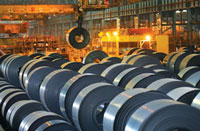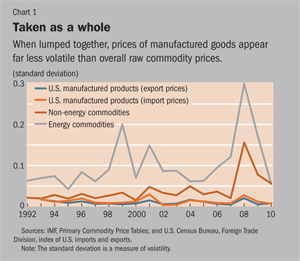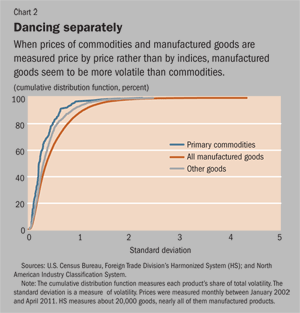Less Volatile than Meets the Eye
Finance & Development, December 2011, Vol. 48, No. 4
Rabah Arezki, Daniel Lederman, and Hongyan Zhao
![]() Moving beyond agriculture
Moving beyond agriculture
![]() Commodity price volatility
Commodity price volatility
Contrary to popular wisdom, commodity prices can be more stable than those of manufactured products
 MOST economists think economic development requires the reallocation of resources from low-productivity to high-productivity uses. The commodity, or primary, sector is seen as a low-productivity area, whereas the manufacturing, or secondary, sector is considered high productivity. Historically, as economies developed, the size of the commodity sector tended to shrink and the noncommodity sectors grew (Kuznets, 1966). Although there are a few exceptions, such as Norway, this apparently consistent relationship between development and the relative size of the commodity sector suggests that an economy will develop successfully if it relies less on commodities and diversifies into other—generally, manufactured—products.
MOST economists think economic development requires the reallocation of resources from low-productivity to high-productivity uses. The commodity, or primary, sector is seen as a low-productivity area, whereas the manufacturing, or secondary, sector is considered high productivity. Historically, as economies developed, the size of the commodity sector tended to shrink and the noncommodity sectors grew (Kuznets, 1966). Although there are a few exceptions, such as Norway, this apparently consistent relationship between development and the relative size of the commodity sector suggests that an economy will develop successfully if it relies less on commodities and diversifies into other—generally, manufactured—products.
Development economists cite several reasons for encouraging such diversification. A major argument is the perceived greater stability of manufacturing prices than of commodity prices, whose volatility chokes efficiency and makes life difficult and unpredictable for consumers, businesses, and government. Our research suggests otherwise. Overall manufacturing price indices are less volatile than those for commodities, but when those indices are broken down into their individual parts (there are about 18,000 different manufactured items) a dramatically different picture emerges.
Prices of individual manufactured goods are often more volatile than those of commodities. Because few developing economies can diversify into more than a handful of new products, the swap may simply be from one volatile product to another. There are valid reasons to diversify away from commodities, but containing price volatility likely should not be among them.
Long-run trend in commodity prices
Probably the oldest and most prominent justification for diversification is the so-called Prebisch-Singer hypothesis (Frankel, forthcoming, surveys the gamut of arguments). The hypothesis, which is controversial, says that in the long run, the prices of mineral and agricultural products relative to the prices of manufactured and other products follow a downward trend because world demand for primary products does not change proportionally to a change in world incomes. This inelastic behavior, as economists put it, means that a 1 percent increase in income would lead to a less than 1 percent increase in the demand for raw materials. The hypothesis echoes what is known as Engel’s Law, which stipulates that households spend a smaller fraction of their income on food and other basic necessities as they get richer. If true, the hypothesis (developed independently by Argentine Raúl Prebisch and German Hans Singer) would argue against specializing in natural resources.
Commodity price volatility
If the Prebisch-Singer hypothesis is among the oldest justifications for diversification, the relative volatility of commodities in relation to manufactured products is among the newest. Cashin and McDermott (2002) provide evidence that the price trend Prebisch and Singer identified is overwhelmed by the volatility of commodity prices.
Oil and natural gas prices are the most volatile, and close behind are those of aluminum, bananas, coffee, copper, and sugar, to name but a few. To compare the prices of raw commodities with the prices of numerous manufactured products, aggregate price indices are often used. Chart 1  shows greater volatility in various international commodity price indices than in manufactured product price indices. Manufactures prices are derived from the manufactured product price indices of U.S. imports and exports calculated by the Foreign Trade Division of the U.S. Census Bureau. We use an index based on U.S. trade data because the size and advanced nature of the U.S. economy guarantee representation of the whole spectrum of goods—that is, the United States imports or exports nearly all goods traded among countries. Chart 1 suggests that countries specializing in raw commodity exports face far greater volatility than those specializing in the exportation of manufactured products.
shows greater volatility in various international commodity price indices than in manufactured product price indices. Manufactures prices are derived from the manufactured product price indices of U.S. imports and exports calculated by the Foreign Trade Division of the U.S. Census Bureau. We use an index based on U.S. trade data because the size and advanced nature of the U.S. economy guarantee representation of the whole spectrum of goods—that is, the United States imports or exports nearly all goods traded among countries. Chart 1 suggests that countries specializing in raw commodity exports face far greater volatility than those specializing in the exportation of manufactured products.
Volatility and growth
Some economists have suggested that volatility in commodity prices is a source of many of the evils developing countries face. Volatility can cause the factors of production (labor, land, capital) to jump around among sectors (for example, among mining, agriculture, manufacturing, services), which gives rise to expensive transaction costs. Volatility can lead to unemployment, incomplete utilization of the capital stock, and incomplete occupancy of housing—which represent important economic and social losses. Volatility not only complicates the saving and investment decisions of households and businesses but also makes it more difficult for government authorities to conduct spending, tax, and monetary policies. And the failure of policies to address volatility may, more often than not, exacerbate boom and bust economic cycles.
Without a broad-based domestic financial sector and access to international financial markets, developing economies may feel an even greater impact from volatility. If commodity prices are truly more volatile than the prices of manufactured goods, the dramatic economic consequences of volatility make a strong case against specializing in the commodity sector.
The source of commodity volatility
Some economists have suggested that volatility in commodity prices is a source of many of the evils developing countries face. Volatility can cause the factors of production (labor, land, capital) to jump around among sectors (for example, among mining, agriculture, manufacturing, services), which gives rise to expensive transaction costs. Volatility can lead to unemployment, incomplete utilization of the capital stock, and incomplete occupancy of housing—which represent important economic and social losses. Volatility not only complicates the saving and investment decisions of households and businesses but also makes it more difficult for government authorities to conduct spending, tax, and monetary policies. And the failure of policies to address volatility may, more often than not, exacerbate boom and bust economic cycles.
Without a broad-based domestic financial sector and access to international financial markets, developing economies may feel an even greater impact from volatility. If commodity prices are truly more volatile than the prices of manufactured goods, the dramatic economic consequences of volatility make a strong case against specializing in the commodity sector.
A misconception about commodity volatility
We questioned the premise that commodity prices are more volatile than the prices of manufactures and other goods. We used individual monthly prices between January 2002 and April 2011 from the Harmonized System—a detailed list of about 20,000 goods constructed by the Foreign Trade Division of the U.S. Census Bureau. When we compared volatility across individual goods, we found that machinery and electrical product prices were the most volatile.
We then classified goods as primary commodities or manufactured products, using the U.S. Census Bureau’s North American Industry Classification System (NAICS). Using standard statistical methods, we determined  which group was more volatile. Chart 2 shows that prices of manufactures, such as machines that make flat-panel displays, are more volatile than those of commodities.
which group was more volatile. Chart 2 shows that prices of manufactures, such as machines that make flat-panel displays, are more volatile than those of commodities.
This result contradicts the information in Chart 1. Why? We think that the use of aggregate indices in comparing prices across classes of goods is subject to an aggregation bias. That is, some price swings in one direction cancel out swings in the other direction, which makes for an overall index that looks more stable than its components. Of course that same effect is also at play in commodity price indices, but there are far fewer commodities than manufactures, so fewer prices cancel each other out. According to NAICS, manufactures account for more than 90 percent of the goods in our data set. It is misleading to compare price volatility using the aggregated data of indices. The data must be disaggregated and volatility computed for each category of goods.
Alternate theories
It is possible that our results had nothing to do with whether the goods were manufactures or commodities. But our examination shows otherwise.
One explanation for our finding involves whether goods are homogeneous, as are most commodities, or differentiated, as are most manufactured products. Differentiation may explain why manufactured products are more volatile than commodities. In our sample, 95 percent of manufactured goods are differentiated, as opposed to only 35 percent of commodities. Overall, we found that homogeneous goods, which can be easily substituted for one another, are less volatile than differentiated products. We used existing categorizations into homogeneous and differentiated products and compared the volatility of individual prices across commodities and manufactures for homogeneous and differentiated groups separately. We found that when we held the level of differentiation constant, individual commodity price volatility was below that of a manufactured product. Whether a good is a commodity or a manufactured good is thus important in determining its relative level of volatility.
Some classes of products disappear over time because of reclassification: certain goods, especially manufactures, change—sometimes rapidly. But do these changes explain our main finding? It is possible that over time incomplete data for the categories that disappear biases our results. But if we limit the analysis to the categories that survived over the entire sample period, our main finding—that the prices of commodities are less volatile than those of manufactures—holds.
Policy implications
This robust empirical evidence from disaggregated trade statistics challenges a commonly held view that commodity prices are relatively more volatile than manufactures prices. In broad terms, this finding calls for reorientation of the development debate from a focus on the danger posed by exports of relatively more volatile commodities to a look at the pitfalls of activity concentrated in the commodity sector. Perhaps, as some authors argue, lack of “connectedness” of the commodity sector with other sectors is what handicaps commodity-exporting countries (Hausmann and Klinger, 2007). In other words, in commodity-exporting countries it is more difficult to reorient factors to produce noncommodity products. This difficulty may stem from the difference in the production processes of commodities and other goods or from scant cross-fertilization of know-how between the commodity sector and other sectors, or both.
Our evidence suggests that specialization in the manufacturing sector does not necessarily lower, but may in fact increase, volatility. Moreover, manufacturing may prove more challenging than commodity specialization: production processes need constant upgrading to keep up with international competition. Although specializing in manufactures should not be ruled out, government authorities must bear in mind the need for a strong capacity to innovate and adapt. Domestic production of manufactured items, however, could be beneficial as a buffer against import price volatility.
Nearly all developing countries have much smaller economies than major industrialized countries and are more likely to specialize in the exportation of basic commodities. This concentration in their export baskets is associated with volatile terms of trade, so management of external volatility and economic diversification remain important long-term policy challenges for developing countries. But not simply because of the volatility of commodity prices.■
Rabah Arezki is an Economist in the IMF Institute and Daniel Lederman is Lead Economist in the World Bank’s International Trade Department, and Hongyan Zhao is a Ph.D. candidate at the University of California, Berkeley.
This article is based on the forthcoming IMF Working Paper “The Relative Volatility of Commodity Prices: A Reappraisal,” by Rabah Arezki, Daniel Lederman, and Hongyan Zhao.
References
Cashin, Paul, and John C. McDermott, 2002, “The Long-Run Behavior of Commodity Prices: Small Trends and Big Variability,” IMF Staff Papers, Vol. 49, No. 2 (Washington: International Monetary Fund), pp. 175–99.
Frankel, Jeffrey, forthcoming, “Natural Resource Curse: A Survey of the Literature,” in Commodity Prices and Inclusive Growth in Low-Income Countries, ed. by Rabah Arezki, Catherine Pattillo, and Marc Quintyn (Washington: International Monetary Fund).
Hausmann, Ricardo, and Bailey Klinger, 2007, “The Structure of the Product Space and the Evolution of Comparative Advantage,” CID Working Paper No. 146 (Cambridge, Massachusetts: Center for International Development).
Kuznets, Simon, 1966, Modern Economic Growth: Rate, Structure, and Spread (New Haven, Connecticut: Yale University Press).
Prebisch, Raúl, 1950, The Economic Development of Latin America and Its Principal Problems (New York: United Nations).
Singer, Hans W., 1950, “U.S. Foreign Investment in Underdeveloped Areas: The Distribution of Gains between Investing and Borrowing Countries,” American Economic Review, Vol. 40, No. 2, pp. 473–85.


